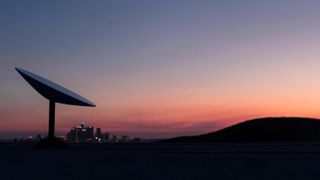
SpaceX CEO Elon Musk has promised that the company’s satellite-based internet service Starlink will see a huge boost to its speeds “later this year,” – encouraging news for anyone who’s put down a deposit on a Starlink beta kit after the company recently opened pre-orders to the public.
Musk made the claim in a tweet, replying to a user who posted their internet speeds following initial setup of the dish and router, saying: “Speed will double to ~300Mb/s & latency will drop to ~20ms later this year.”
Starlink recently expanded its beta testing program, inviting members of the public to put down a $99 deposit on a kit that includes the dish antenna and router.
The user Musk was replying to had mentioned earlier in the same thread that their original speed test clocked in at 77Mbps with a latency of 44ms. They later ran a test which saw the speed increase to 130Mbps, with the caveat that they were standing next to the router when performing it.
- SpaceX: everything you need to know
- Everything you need to know about SpaceX's Starlink
- SpaceX is big winner at billion dollar US rural broadband funding
Reach for the stars
Currently, Starlink’s website promises internet speeds of around 50 to 150Mbps, which is in line with the Twitter user’s speed tests. Musk’s comments also echo claims on the website that speeds are set to “improve dramatically” as the Starlink network grows.
However, let’s keep in mind that this is Elon Musk we’re talking about, who has made more eccentric claims in the past, like making the Tesla Roadster a hover car, and saying he’s 70% sure he’ll be moving to Mars.
That said, Musk’s comments on the improvements to Starlink internet speeds are grounded in reality – 300Mbps isn’t unheard of – but given his track record of eccentricities it’s worth taking his predictions with a grain of salt.
Get daily insight, inspiration and deals in your inbox
Get the hottest deals available in your inbox plus news, reviews, opinion, analysis and more from the TechRadar team.
Replying to another tweet asking about Starlink’s coverage map, he said: “Most of Earth by end of year, all by next year, then it’s about densifying coverage.”
It’s a lofty goal, sure, and in the same Twitter thread Musk went on to talk about how cellular internet is better for densely populated areas, while Starlink was better suited to places with low to medium population densities – so villages or rural areas that can’t access fast and reliable internet via mast-based or cabled networks.
While some were initially skeptical about Musk’s plans for a space-based internet service, Starlink has shown that it isn’t just smoke and mirrors. SpaceX has been hard at work on the project, and it accounts for roughly a quarter of all satellites currently in orbit. The end goal is to have a total of 12,000 satellites providing cheap, high-speed internet with planet-wide coverage.
Starlink’s achievements so far are laid out in its Application for ETC Designation. In it, the company states that over 10,000 users are already benefiting from Starlink’s public beta program, enjoying speeds above the expected baseline.
If you’re keen to try out Starlink for yourself, you can put down a $99 deposit at SpaceX’s website for the antenna and router kit – the full price is $499. The kits are available on a “first come, first served basis” to a limited number of people in each coverage area. This means that depending on where you live, if your order is accepted you could be waiting until mid-to-late 2021 or 2022 to get your kit.
It remains to be seen if Starlink can deliver on these promised speed improvements, but we'd love to see Musk making good on his promise to bring better internet access to areas that are currently poorly served.

Rhys is TRG's Hardware Editor, and has been part of the TechRadar team for more than two years. Particularly passionate about high-quality third-party controllers and headsets, as well as the latest and greatest in fight sticks and VR, Rhys strives to provide easy-to-read, informative coverage on gaming hardware of all kinds. As for the games themselves, Rhys is especially keen on fighting and racing games, as well as soulslikes and RPGs.
Most Popular

